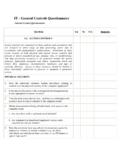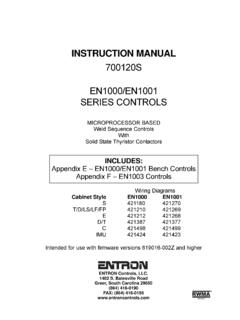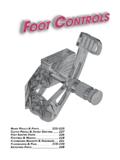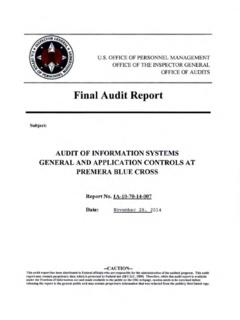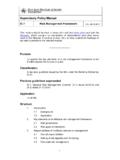Transcription of Information Technology Audit - intosaiitaudit.org
1 1IT Audit Monograph Series # 1 Information Technology AuditGeneral PrinciplesIntroductoryAs computer Technology has advanced, Government organisations have become increasinglydependent on computerised Information systems to carry out their operations and to process,maintain, and report essential Information . As a consequence, the reliability of computerised dataand of the systems that process, maintain and report these data are a major concern to Audit . ITAuditors evaluate the reliability of computer generated data supporting financial statements andanalyse specific programs and their outcomes. In addition, IT Auditors examine the adequacy ofcontrols in Information systems and related operations to ensure system Audit is the process of collecting and evaluating evidence to determine whether a computersystem has been designed to maintain data integrity, safeguard assets, allows organisational goalsto be achieved effectively, and uses resources efficiently.
2 Data integrity relates to the accuracyand completeness of Information as well as to its validity in accordance with the norms. Aneffective Information system leads the organisation to achieve its objectives and an efficientinformation system uses minimum resources in achieving the required objectives. IT Auditormust know the characteristics of users of the Information system and the decision makingenvironment in the auditee organisation while evaluating the effectiveness of any of computer facilities has brought about radically different ways of processing, recordingand controlling Information and has combined many previously separated functions.
3 Thepotential for material systems error has thereby been greatly increased causing great costs to theOrganisation, , the highly repetitive nature of many computer applications means that smallerrors may lead to large losses. An error in the calculation of Income Tax to be paid byemployees in a manual system will not occur in each case but once an error is introduced in acomputerised system, it will affect each case. A bank may suffer huge losses on account of anerror of rounding off to next rupee instead of nearest rupee. This makes it imperative for theauditor to test the invisible processes, and to identify the vulnerabilities in a computerinformation system as the costs involved, because of errors and irregularities, can be in a Computer SystemComputer systems are efficient and achieve results accurately and at great speed if they work theway they are designed to.
4 They have controls provided to ensure this but the controls have to beeffective. The controls are of great value in any computerised system and it is an important taskfor an auditor to see that not only adequate controls exist, but that they also work effectively toensure results and achieve objectives. Also controls should be commensurate with the riskassessed so as to reduce the impact of identified risks to acceptable in a computer Information system reflect the policies, procedures, practices andorganisational structures designed to provide reasonable assurance that objectives will beachieved. The controls in a computer system ensure effectiveness and efficiency ofoperations, reliability of financial reporting and compliance with the rules and system controls are broadly classified into two broad categories: general Controls Application controlsGeneral controls include controls over data centre operations, system software acquisition andmaintenance, access security, and application system development and maintenance.
5 They createthe environment in which the application systems and application controls operate. Examplesinclude IT policies, standards, and guidelines pertaining to IT security and informationprotection, application software development and change controls, segregation of duties, servicecontinuity planning, IT project management, controls pertain to specific computer applications. They include controls that help toensure the proper authorisation, completeness, accuracy, and validity of transactions,maintenance, and other types of data input. Examples include system edit checks of the format ofentered data to help prevent possible invalid input, system enforced transaction controls thatprevent users from performing transactions that are not part of their normal duties, and thecreation of detailed reports and transaction control totals that can be balanced by various units tothe source data to ensure all transactions have been posted completely and of controlsPresence of controls in a computerised system is significant from the Audit point of view as thesesystems may allow duplication of input or processing, conceal or make invisible some of theprocesses.
6 And in some of the auditee organisations where the computer systems are operated byoutside contractors employing their own standards and controls, making these systemsvulnerable to remote and unauthorised from this, the significance of controls lies in following possibilities:(i) data loss due to file damage, data corruption (manipulation), fire, burglary, power failure (orfluctuations), viruses (ii) error in software can cause manifold damage as one transaction in a computer system mayaffect data everywhere;(iii) computer abuse like fraud, vengeance, negligent use etc. is a great potential danger and(iv) absence of Audit trails make it difficult for an auditor to ensure efficient and effectivefunctioning of a computerised of Computer ControlsThe objectives of controls do not change with the introduction of computers.
7 It is the controltechniques that change with many of the manual controls being computerised and new technicalcomputer controls added to achieve the same objectives. Typical control objectives within agovernment Data Processing function are to ensure:(i) provision of effective organisational control over functions related to Data Processing byclearly defining organisational objectives;(ii) effective management control over development of Data Processing resources in accordanceorganisational objectives;(iii) practices related to Data Processing activities in accordance with statutory requirements anddown administrative procedures;(iv) formulation of an adherence to policies, standards and procedures for all functions related toData Processing and(v) efficiency and effectiveness of the Data Processing systems towards achievement of itsdesired evaluationThe first step in Audit should be preliminary evaluation of the computer systems covering:(i) how the computer function is organised.
8 (ii) use of computer hardware and software,(iii) applications processed by the computer and their relative significance to the organizationand(iv) methods and procedures laid down for implementation of new applications or revision toexisting course of preliminary evaluation, the auditor should ascertain the level of control awareness inthe auditee Organisation and existence (or non-existence) of control standards. The preliminaryevaluation should inter alia identify potential key controls and any serious key control4weaknesses. For each control objective the auditor should state whether or not the objective hasbeen achieved; if not, he should assess the significance and risks involved with due to methodologyAfter completing the preliminary evaluation of the computer systems, the auditor has to decideabout the appropriate Audit approach, system based or direct substantive testing.
9 In doing so, theaspects to be borne in mind are:(i) results of the preliminary evaluation(ii) extent to which reliance can be placed on any work carried out by Internal Audit and(iii) nature of any constraints like lack of any Audit trail and the practicability of testing.(iv) effective compliance testing of key computer controls (which may be difficult) and(v) each control to be tested will require large Direct Substantive TestingIf Direct Substantive Testing approach is chosen, a sample of transactions should be selected andtested. Result of the preliminary evaluation will be of help particularly as it would have:(i) provided an overall assessment of the control environment and identified any seriousweaknesses which should be raised with the auditee,(ii) given sufficient familiarity with the system to be able to decide the point from which toselect the transactions for testing and how to substantiate them efficiently and(iii) provide sufficient Information to determine any initial requirement for any Systems Based AuditFor System Based Audit approach, aspects of regularity, economy, efficiency and effectivenessof the system have to be looked into besides evaluating data integrity, and data security asexplained below.
10 (i) System effectiveness is measured by determining whether the system performs the intendedfunctions and whether users get the needed Information , in the right form when required;(ii) A system is economical and efficient if it uses the minimum number of informationresources to achieve the output required by the users. The use of system resources - hardware,software, personnel and money - should be optimized;(iii) System activities would be regular if they comply with applicable laws, rules, policies,guidelines etc;(iv) Achieving data integrity implies that the internal controls must be adequate to ensure that5error are not introduced when entering, communicating, processing, storing or reporting data;and(v) Data system resources, like other assets, must be sufficiently protected against theft, waste,fraud, unauthorized use a



